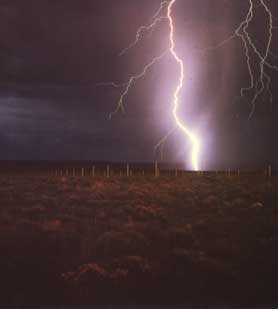Science Fiction
Dictionary
A B C D E F G H I J K L M N O P Q R S T U V W X Y Z
Weather As Art

In the aftermath of hurricane Katrina, many of us are wishing that we had some sort of control over the weather. Science fiction writer John Varley even thought about how we might become weather artists in his 1976 novel The Phantom of Kansas. Remarkably, there are real weather artists who try to make what beauty they can from nature's worst storms.
The novel is set on Earth's moon; enormous interior caverns are dug to create vast lunar disneylands, spaces in which Earthlike environments are simulated:
These caverns were big enough to have their own weather, and they did. People who programmed the weather started out with nice days, but eventually started tinkering until the storms and sunsets were good enough to be able to charge admission. One of the best artistic creations was called Cyclone:
In the mid-nineteen seventies, artist Walter de Maria created The Lightning Field near Quemado, New Mexico. It consisted of 400 stainless steel poles averaging just over twenty feet in height. The overall dimensions were 5,280 x 3,300 feet.
The Kansas disneyland was one of the newer ones, and one of the largest. It is a hollowed-out cylinder twenty kilometers beneath Clavius. It measures two hundred and fifty kilometers in diameter and is five kilometers high. The curvature of the floor is consistent with Old Earth so the horizon is terrifyingly far away. Only the gravity is Lunar.
(Read more about the lunar disneyland)
Cyclone has a definite beginning, however. At least to the audience. It begins with the opening bolt of lightning. I worked on it a long time, and designed it to shatter nerves. There is the slow building of thunderheads ... then it hits. It crashes in at seventeen points in a ring around the audience, none further away than a half a kilometer. It is poperly called chain lightning, because after the initial discharge it keeps flashing for a full seven seconds. It's designed to take the hair right off your scalp...
(Read more about this environmental happening)

(From The Lightning Field)
Writers sometimes say you should write what you know, advice Varley took to heart with his story. He had a childhood encounter with Hurricane Andrew in Port Arthur, Texas. A category 4 storm, it killed hundreds of people in nearby Louisiana.
The earliest science fiction reference I know about for control of the weather is in John Jacob Astor's 1894 novel A Journey in Other Worlds - people use aeriducts to make rain at will; complete control over all weather is also foreseen. Other more modern references include the weather integrators found in Robert Heinlein's 1940 novel Methuselah's Children and the regular showers in the lunar habitats from Arthur C. Clarke's 1955 novel Earthlight. Human beings have, of course, been trying to figure out how to manipulate the weather since the dawn of recorded history.
Thanks to Blue Monkey for contributing the tips on this story.
Scroll down for more stories in the same category. (Story submitted 9/13/2005)
Follow this kind of news @Technovelgy.| Email | RSS | Blog It | Stumble | del.icio.us | Digg | Reddit |
Would
you like to contribute a story tip?
It's easy:
Get the URL of the story, and the related sf author, and add
it here.
Comment/Join discussion ( 2 )
Related News Stories - (" Culture ")
Liuzhi Process Now In Use In China
'He was in a high-ceilinged windowless cell with walls of glittering white porcelain.' - George Orwell, 1984.
Animated Tumblebugs On Astounding Cover!
'Gaines and Harvey mounted tumblebugs, and kept abreast of the Cadet Captain...'
Has Elon Musk Given Up On Mars?
'There ain't no such thing as a free lunch.'
'They Erased My Memory' Says Ariana Grande
'...using a neutralizing electronic impulse.' - Edmond Hamilton, 1948.
Technovelgy (that's tech-novel-gee!) is devoted to the creative science inventions and ideas of sf authors. Look for the Invention Category that interests you, the Glossary, the Invention Timeline, or see what's New.
Science Fiction
Timeline
1600-1899
1900-1939
1940's 1950's
1960's 1970's
1980's 1990's
2000's 2010's
Current News
Jetson ONE Air Races Begin, Can Air Polo Be Far Behind?
'If you're one of those rarities who haven't attended a rocket-polo "carnage", let me tell you it's a colorful affair.'
Will Space Stations Have Large Interior Spaces Again?
'They filed clumsily into the battleroom, like children in a swimming pool for the first time, clinging to the handholds along the side.'
Mornine Sales Robot
'Robot-salesmen were everywhere, gesturing...'
Bipedal Robot Floats Gently While Walking
'a walking balloon proceeded with long strides of its aluminum legs...'
Musk Idea Of Cars Talking To Each Other Predicted 70 Years Ago
'My cars talk to one another.'
Elegant Bivouac Shelter Produces Water And Electricity
'There was nowhere on the planet where science and technology could not provide one with a comfortable home...'
X-Control Janus-1 A Suitcase Aircraft
'You will notice that it... fits the suitcase nicely.'
'AI Assistants' Are Actually Less Reliable For News
'Most men updated their PIP on New Year's Day...'
YES!! Remote Teleoperated Robots predicted by Technovelgy!
'...a misshapen, many-tentacled thing about twice the size of a man.'
Will Robots Ever Fold Landry?
Where have you gone, Mrs. Robinson?
Will AIs Give Better Results If You're Rude To Them?
'I said, "Listen up, motherf*cker.'
Cybertruck Robotic Arm F10 Drone Launch!
Drone away!
Black Fungus Blocks Radiation
'You were surrounded by Astrophage most of the time'
Liuzhi Process Now In Use In China
'He was in a high-ceilinged windowless cell with walls of glittering white porcelain.'
Reflect Orbital Offers 'Sunlight on Demand' And Light Pollution
'I don't have to tell you about the seven two-mile-diameter orbital mirrors...'
Will Robots Become Family Caregivers?
'The robant and the tiny old woman entered the control room slowly...'
